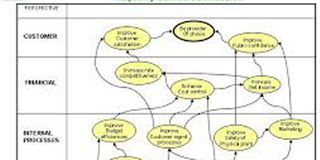It helps to have a formal strategy implementation system

A corporate strategy map. PHOTO | GOOGLE IMAGES
What you need to know:
- The scope should be about the niche the enterprise intends to serve.
- It is important to remember not to blame managers for reporting problems.
- All this done, the professor emphasised the need for great leadership, particularly change leadership.
I had the rare privilege, the other day, of listening to one of the most renowned professors of strategy.
Robert Kaplan was in the country to talk to top corporate executives about the balanced scorecard and strategy implementation.
In a very simplified manner, he spoke about strategy execution as the number one priority for senior executives. Breakthrough performance is achievable through a formal strategy implementation system.
The Kaplan-Norton 6 Stage Strategy Execution System starts with strategy development, with a clear vision, mission, values, and strategies. It works to summarise a strategy using the vision, advantage and scope (VAS) framework.
The vision should describe what the strategy is designed to achieve. It should be a quantifiable target with a time frame. The advantage should be about how the organisation is to achieve its objective — how it will design, produce, or deliver differently compared with competitors.
It should define the unique value proposition to its customers.
The scope should be about the niche the enterprise intends to serve.
The second stage is to plan the strategy by creating the strategy map. The strategy map translates the strategy into action. It starts with the strategic objectives that you intend to achieve. It also states how success or failure is going to be measured.
As well as the targets, it clearly defines the levels of performance, or levels of improvement. This includes the key action programmes required to achieve targets. This is the point at which strategic themes are crafted and related to group objectives.
The third stage involves aligning the organisation and the people to the strategy through four human resource processes. You create strategic awareness by communicating.
You communicate and communicate and continuously communicate. It will have to be repeated in many different ways.
Personal goals are then aligned to the strategy through a personal scorecard. As you align the personal scorecard, it helps to arm the people with the necessary skills to execute their part of the strategy. This means focused and relevant training.
The reward system and incentives should also be aligned to the strategy maps. The fourth stage involves planning the operations. This is effectively achieved by linking strategy to operational excellence.
Quality is aligned to continuous improvement programmes and the strategic objectives. This is where the quality assessment model comes in; to help you create dashboards that articulate the critical link between strategy management and operations management.
Kaplan cited examples of Malcolm Baldridge and EFQM, the equivalents of our local organisational performance index — OPI — as the possible tools to deploy at this stage.
There is then the review and monitoring stage, characterised by operational review meetings, which should be preceded by distribution of accurate and timely information.
It is important to remember not to blame managers for reporting problems. The purpose should, instead, be to understand the problems, react to them, and develop solutions that can be implemented rapidly.
The very final stage should then be to test and adapt the strategy to environmental changes and realities. It is the time to ask why you missed the targets, what corrective actions you should consider, and whether all the initiatives are on schedule.
Is the data consistent with your strategic hypotheses? Has the environment changed in a big way? Are there new strategic options?
All this done, the professor emphasised the need for great leadership, particularly change leadership.
Mr Muturi is the executive director, Kenya Institute of Management.




